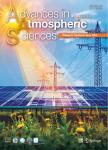Tropical Cyclones and Polar Lows: Velocity, Size, and Energy Scales, and Relation to the 26℃ Cyclone Origin Criteria
Tropical Cyclones and Polar Lows: Velocity, Size, and Energy Scales, and Relation to the 26℃ Cyclone Origin Criteria作者机构:A.M.Obukhov Institute of Atmospheric PhysicsRussian Academy of SciencesMoscow 119017Russian Federation
出 版 物:《Advances in Atmospheric Sciences》 (大气科学进展(英文版))
年 卷 期:2009年第26卷第3期
页 面:585-598页
核心收录:
学科分类:07[理学] 070601[理学-气象学] 0706[理学-大气科学] 0816[工学-测绘科学与技术] 0825[工学-航空宇航科学与技术]
基 金:the grant of the RF President SS4166 2006.5 the Program of the Presidium of RAS"Mathematical Methods of Nonlinear Dynamics"
主 题:typhoons polar lows velocity size and energy scales cyclone origin criteria
摘 要:The goal of this paper is to quantitatively formulate some necessary conditions for the development of intense atmospheric vortices. Specifically, these criteria are discussed for tropical cyclones (TC) and polar lows (PL) by using bulk formulas for fluxes of momentum, sensible heating, and latent heating between the ocean and the atmosphere. The velocity scale is used in two forms: (1) as expressed through the buoyancy flux b and the Coriolis parameter Ic for rotating fluids convection, and (2) as expressed with the cube of velocity times the drag coefficient through the formula for total kinetic energy dissipation in the atmospheric boundary layer. In the quasistationary case the dissipation equals the generation of the energy. In both cases the velocity scale can be expressed through temperature and humidity differences between the ocean and the atmosphere in terms of the reduced gravity, and both forms produce quite comparable velocity scales. Using parameters b and Ic, we can form scales of the area and, by adding the mass of a unit air column, a scale of the total kinetic energy as well. These scales nicely explain the much smaller size of a PL, as compared to a TC, and the total kinetic energy of a TC is of the order 1018 - 1019 J. It will be shown that wind of 33 m s^-1 is produced when the total enthalpy fluxes between the ocean and the atmosphere are about 700 W m-2 for a TC and 1700 W m-2 for a PL, in association with the much larger role of the latent heat in the first case and the stricter geostrophic constraints and larger static stability in the second case. This replaces the mystical role of 26℃ as a criterion for TC origin. The buoyancy flux, a product of the reduced gravity and the wind speed, together with the atmospheric static stability, determines the rate of the penetrating convection. It is known from the observations that the formation time for a PL reaching an altitude of 5-6 km can be only a few hours, and a day, or even half a day, for



